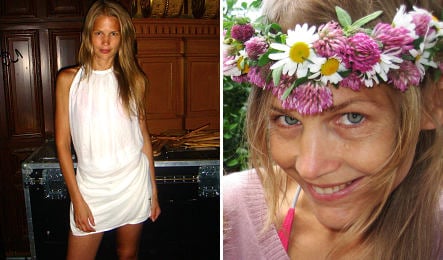But one model-turned-designer stole the spotlight. With her lush, feminine dresses mixed with playful jewelry, designer Karin Säby showed viewers that Swedish fashion can be more than neutral colours and understated clothing.
The Local spoke with Säby after her runway show on Tuesday, and she spoke about everything from her past modeling career to her plans for the future.
Säby grew up in Vaxholm, a small island outside of Stockholm. She admits that as a child, she wasn’t really aware of fashion.
“I grew up in the country, and I had an interest in clothing but I didn’t know anything about fashion,” Säby tells The Local. “I loved to make clothes and create my own outfits, but I wouldn’t say that I knew what I was doing.”
It wasn’t until a chance meeting in the U.S. that Säby began modeling at age 20. She soon became immersed in the high fashion world, doing campaigns for designer labels such as Chanel and Tommy Hilfiger. She became the “It” girl for Tommy Hilfiger and went on to build a tremendously successful career in the modeling industry.
After five years, Säby retired from the modeling world, but she soon grew restless and missed a life of fashion. Säby decided it was time for a change.
“On my 25th birthday, I was at my home in Stockholm with all my close friends and family,” she says. “That was when I felt that I had to go back to my roots. I wanted some stability back in my life.”
Säby officially moved back to Sweden, enrolling herself in sewing lessons and practicing sketches and illustrations. She then created her own clothing line, Karin Säby Design. Säby says what differentiates her from other Swedish designers is that she isn’t afraid to take some risks.
“For me, fashion is more of an extravaganza than what most Swedish designers are used to,” Säby explains. “I don’t think about if the piece will sell a lot or not. I think more about using clothing as a work of art than commercial use. It’s not couture, but it’s more dressy than most Swedish clothes.”
While her collection may be more artwork than commercial clothing, Säby emphasizes that it is always her intention to make women feel unique and happy by wearing her clothes.
“I want them to feel pleased with themselves. My clothing should make their day easier. They should feel beautiful, special, feminine. This may sound superficial, but clothes can really bring your mood up when you are having a bad day.”
Säby says her focus is on her own work, but she always has time to admire and learn from other designers.
“I have so many favorite designers. Christian Dior, Stella McCartney, Christian Lacroix,” Säby says. “There is just no end. Everyone has a great talent, and I can always learn from them.”
Although many areas of fashion do inspire Säby, she gets most of her inspiration from the past and everyday life.
“I get a lot of inspiration from history,” she says. “I mean, clothing has been around for as long as we know, so there must be things that are really outstanding from the past. I also get a lot of inspiration from children’s books and doing things with my son.”
At the moment, Säby is content and grateful with her job as a fashion designer, but she has no idea how long she will continue to be a designer.
“I have to take it one day at a time. If someone told me I had to do this for 10 years, I would quit,” she says. “I need to live in the now. It’s hard work, but living in the moment, that’s what keeps me going.”
Säby was very pleased with how her show turned out on Tuesday, but she says there is room for more improvement.
“I still have more to climb to reach where I want to be. I’m not expecting to reach it by my next collection or anything, but hopefully I will in a few years. Someday I want to come back to New York with my collection. That would be wonderful if I could do that.”
Säby will be wrapping up the week with more interviews with the press as well as contacts with buyers to plan for the next fashion week.
See also: PHOTO GALLERY




 Please whitelist us to continue reading.
Please whitelist us to continue reading.
Member comments